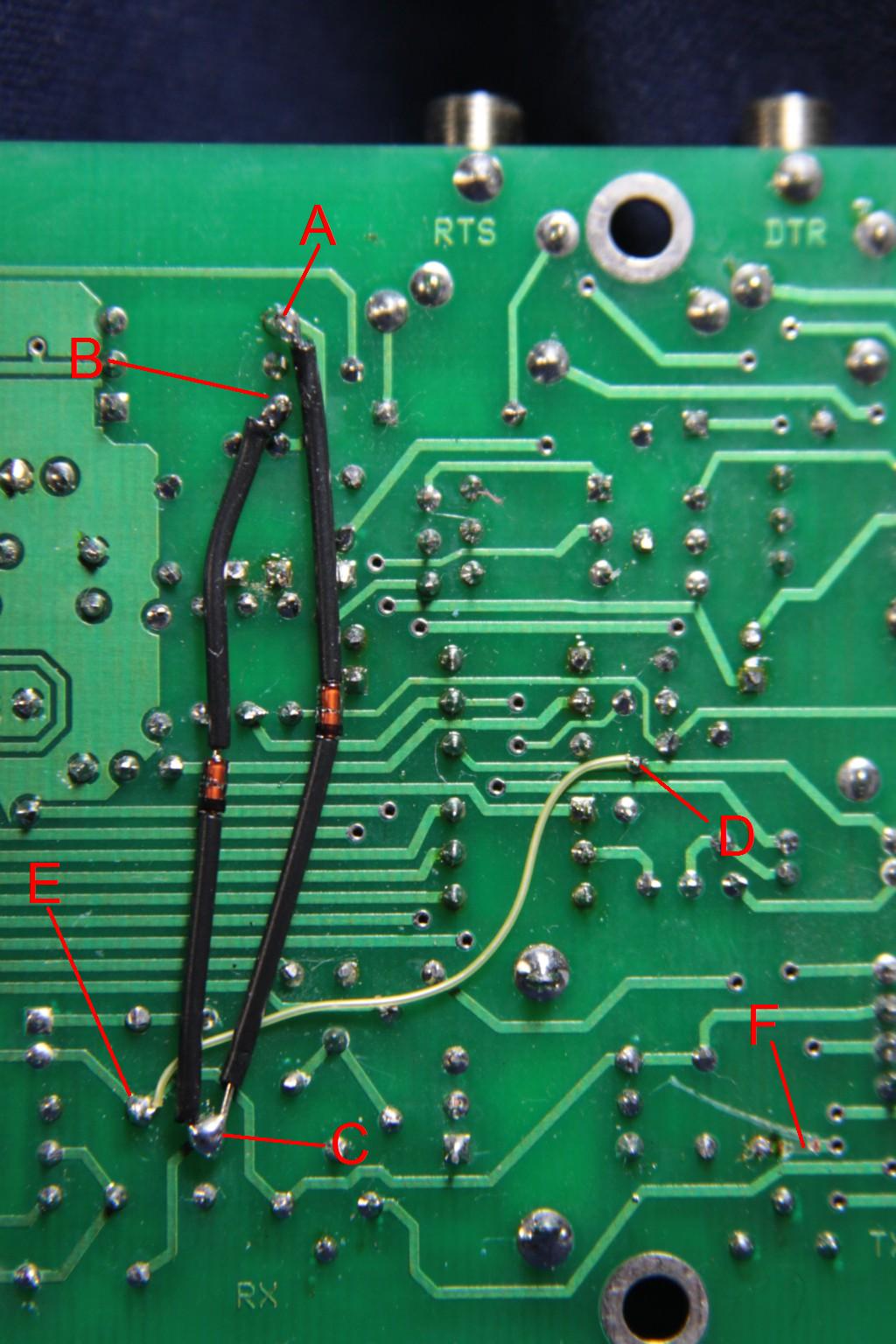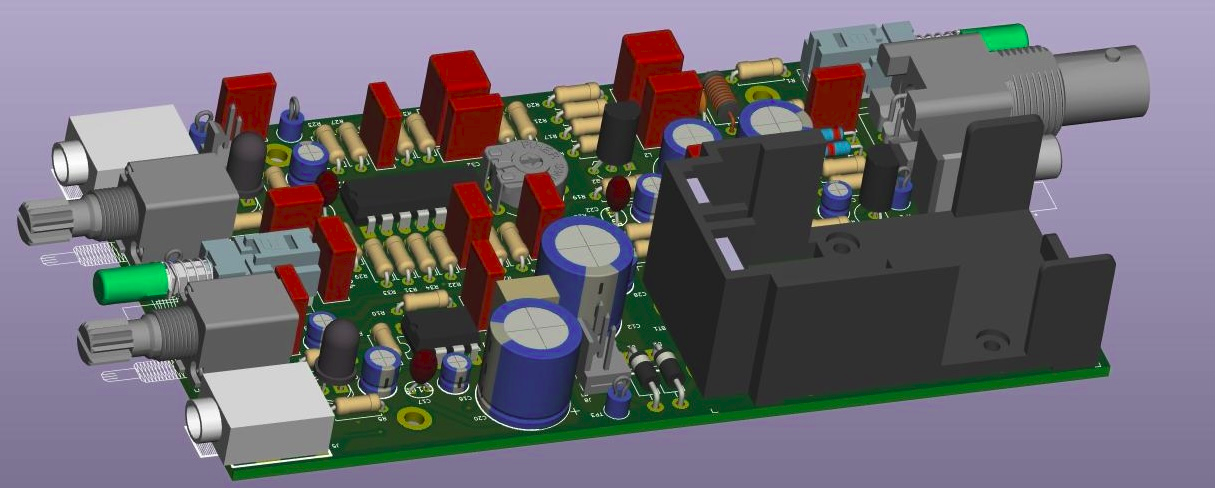As originally designed, the transceiver supplies the modest power requirements of the IsoCat internal audio buffer. When using the interface with Yaesu transceivers (FT-817, FT-857, FT-897), the cabling between the transceiver and the IsoCat is greatly simplified if power for the internal buffer is obtained from the isolated USB power source. This modification may also be applicable to some older transceivers. To perform the modification, refer to the revised schematic and the steps below.
PC board modification
To modify the IsoCat, in addition to a well-lit workspace with adequate static protection, you will need the following tools:
- A soldering iron with a fine tip (15 to 25 watt or a temperature controlled model)
- A pair of small diagonal cutters
- A pair of needle nose pliers with fine tips
- A #2 Phillips screwdriver
Obtain the following components before beginning:
- Two 1N914 diodes
- Small diameter insulation (1/16" heatshrink or similar)
- Insulated wire, #28 or #30 (wire wrap wire is suggested)
To modify the IsoCat PC board, perform the following steps:
- Turn the IsoCat bottom side up, remove the four screws that secure the top cover, and then separate the top cover from the bottom cover/PC board assembly.
- Remove the four screws that secure the PC board to the bottom cover. Set the screws and nylon washers aside.
- Lift the PC board from the bottom cover and turn it over. Be careful not to bend the leads to the LEDs.
- Slip a 1" piece of insulation over the anode wire of one 1N914, clip the lead approximately 1/16" beyond the end of the insulation and solder it to point A in Figure 1.
- Slip a 1" piece of insulation over the cathode wire of the 1N914, clip the lead approximately 1/16" beyond the end of the insulation and solder it to point C in Figure 1.
- Slip a 1" piece of insulation over the anode wire of the second 1N914, clip the lead approximately 1/16" beyond the end of the insulation and solder it to point B in Figure 1.
- Slip a 1" piece of insulation over the cathode wire of the second 1N914, clip the lead approximately 1/16" beyond the end of the insulation and solder it to point C in Figure 1.
- Cut the #30 wire to a length of 2", and then strip 1/16" insulation from each end of the wire.
- Solder 1 end to point D and the other end to point E.
- If the IsoCat will be moved between Icom and Yaesu transceivers, I recommend cutting the trace at point F. This optional step disconnects any externally supplied from the transceiver.
-
Turn the PC board over, position it on the bottom cover, and then reinstall the 4 spacer washers and mounting screws.
CAUTION: To avoid possible damage to the bottom cover, do not over-tighten the mounting screws.
IMPORTANT: Be sure to place a nylon washer on each screw before installing it. - Align the four LEDs with the openings in the top cover, seat the top cover on the bottom cover, and then reinstall the four retaining screws.

Figure 1 - PC Board Modifications
Alternate cabling
Cabling may be greatly simplified as a result of this modification. For example, the cabling for the FT-817, FT-857, and FT-897, the power cable between the CAT connector and the data connector is not necessary after this modification. This makes for a much neater cable set. See the cabling diagrams for the cabling details.
Yaesu 897 menu settings
Suggested settings are green.
MENU MODE No•037 [DIG GAIN]
- Function: Adjusts the audio input level from terminal equipment (such as a TNC or PSK-31sound card) during DIG (Digital) mode operation.
- Available Values: 0 ~ 100
- Default: 50
MENU MODE No•038 [DIG MODE]
- Function: Selects the mode and sideband (if applicable) in the DIG (Digital) mode.
- Available Values: RTTY-L/RTTY-U/PSK31-L/PSK31-U/USER-L/USER-U
- Default: RTTY-L
- RTTY-L: AFSK RTTY operation on the LSB mode
- RTTY-U: AFSK RTTY operation on the USB mode
- PSK31-L: PSK-31 operation on the LSB mode
- PSK31-U:PSK-31 operation on the USB mode
- USER-L: User-programmed custom operation based on LSB mode
- USER-U: User-programmed custom operation based on USB mode
In the USER-L and USER-U modes, you can define the display frequency offset and carrier frequency offset by Menu Mode No-036 [DIG DISP] and No-039 [DIG SHIFT].
Either option should work. This seems to be more about changing the display than changing the internal switching.
MENU MODE No•039 [DIG SHIFT]
- Function: Defines the carrier frequency offset during DIG (USER-L or USER-U) mode operation.
- Available Values: –3000 ~ +3000 Hz
- Default: 0 Hz
MENU MODE No•071 [PKT1200]
- Function: Adjusts the audio input level from the TNC during 1200 bps Packet operation.
- Available Values: 0 ~ 100
- Default: 50
MENU MODE No•072 [PKT9600]
- Function: Adjusts the audio input level from the TNC during 9600 bps Packet operation.
- Available Values: 0 ~ 100
- Default: 50 Set to 0
MENU MODE No•073 [PKT RATE]
- Function: Sets the transceiver’s circuitry for the Packet baud rate to be used.
- Available Values: 1200/9600 (bps)
- Default: 1200 (bps)
Before attempting to transmit, select an appropriate digital mode frequency and USB mode, turn the transmit power down to 20 or 25 watts, and switch the radio to digital mode. Turn the computer output sound level all the way down, and then initiate a short test transmission. Slowly bring the sound level up to see if you get output. Monitor the ALC level and set the sound level to just below the point where you see ALC activity.
